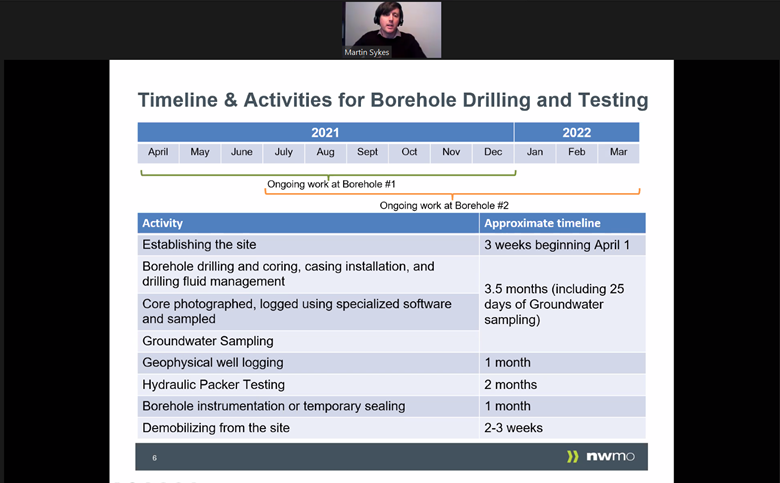Members of the South Bruce Community Liaison Committee (CLC) learned about the Nuclear Waste Management Organization’s (NWMO) borehole drilling and testing activities, slated to begin in the coming weeks, at the potential repository site northwest of Teeswater, Ont.
Martin Sykes, Senior Geoscientist at the NWMO and Project Manager for the borehole drilling and testing program in South Bruce, provided the update. Mr. Sykes has experience conducting, managing and supervising borehole drilling, testing and other fieldwork projects across Canada.
“These activities will give us a deeper understanding of the rock beneath the surface and build on our existing knowledge about the geology at the potential repository site to help confirm if it’s a safe location for a repository,” said Mr. Sykes.
The NWMO is planning to begin borehole drilling and testing in the spring. In addition to the borehole activities, the NWMO will be installing and gathering information from micro-seismic monitoring stations, and installing shallow groundwater monitoring wells to further understand the geology and groundwater system in the area.
Later this fall, seismic surveys will be completed that will generate a 3D image of the geology.
The NWMO completed of the access road and drill pad for the first borehole at the end of 2020, and pre-construction for the second borehole wrapped up earlier this year.
In a few weeks, the NWMO’s contractor will begin setting up the first borehole site with equipment and services to prepare for drilling. This will take about three weeks, and involves installing fencing and lighting at the site, office trailers, and other items such as the drill rig and testing equipment.
Once the site is established, work at the borehole location will last approximately nine months. This will include approximately three and a half months for the drilling itself, and several months for additional downhole testing, which involves gathering data of the rock at different depths within the borehole. After drilling of the first borehole is complete, drilling of the second will begin and run concurrently with downhole testing in the first borehole.
What to expect during drilling
“The NWMO is committed to protecting and enhancing the well-being of the communities where we live and work, and we have taken many factors into consideration to minimize disruptions to neighbours,” noted Mr. Sykes.
This includes berming of the soil at the borehole sites and selection of the borehole locations behind outbuildings to minimize noise and light, using existing power lines in place of generators to minimize noise and emissions, and locating boreholes away from houses.
Mr. Sykes also shared information on traffic considerations in the neighbourhood, “Traffic will be busiest during the first few weeks in April and level off to about 10 to 15 vehicles per day for those working at the borehole sites.”
Protecting and understanding water
Mr. Sykes outlined the NWMO’s deep commitment to protecting water throughout the drilling process by highlighting the borehole casing program. It involves installing steel casing from the surface into the upper bedrock to protect shallow aquifers. This step prevents mixing between shallower fresh water that local water wells draw their water supply from and deeper water that has different chemistry.
“We are applying industry best practice in all our work, and the casing program is just one example. The casing will ensure that groundwater is protected during drilling and afterwards,” noted Mr. Sykes.

